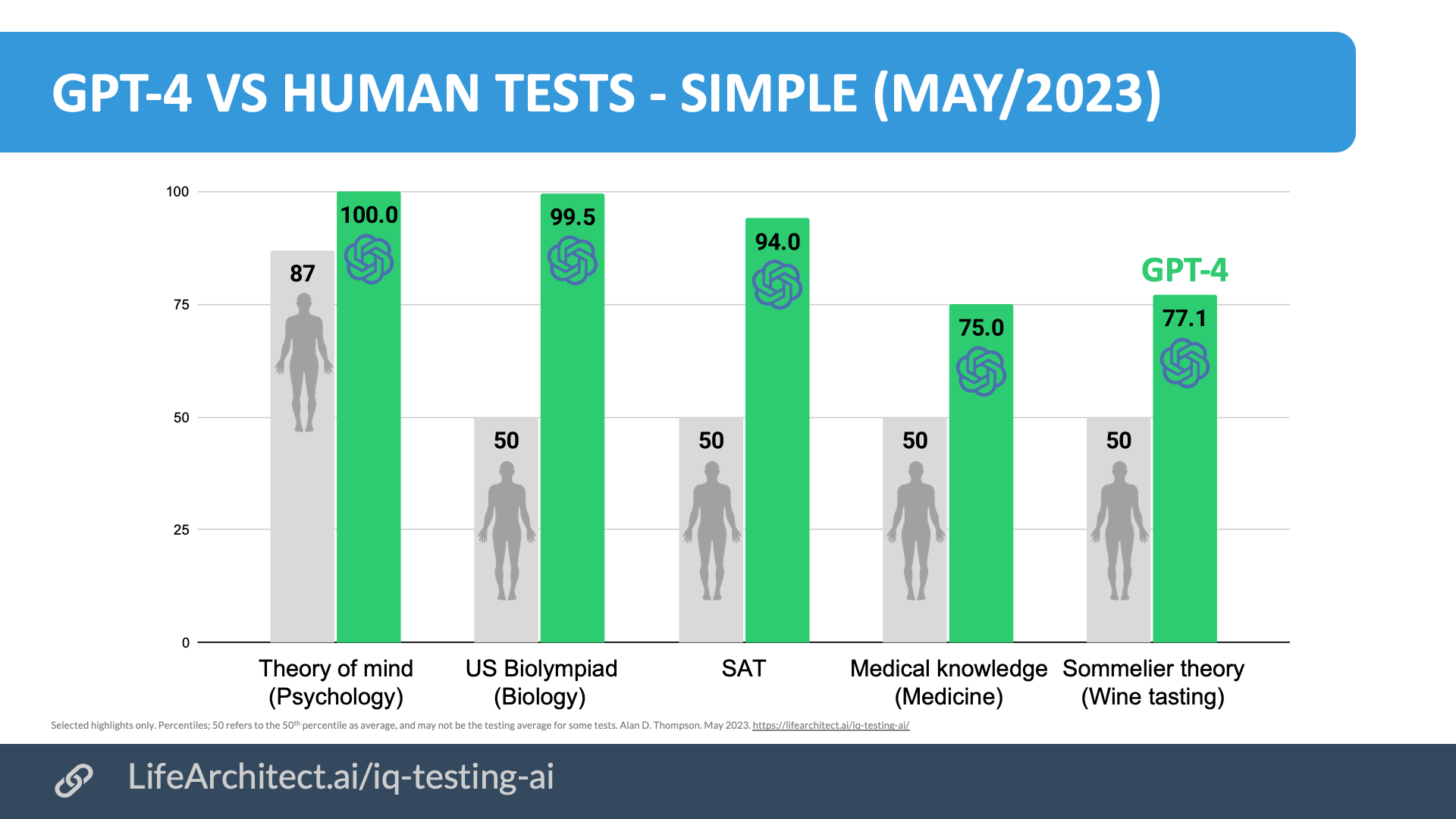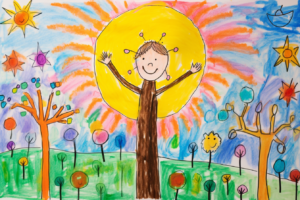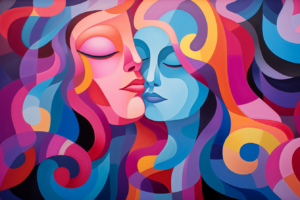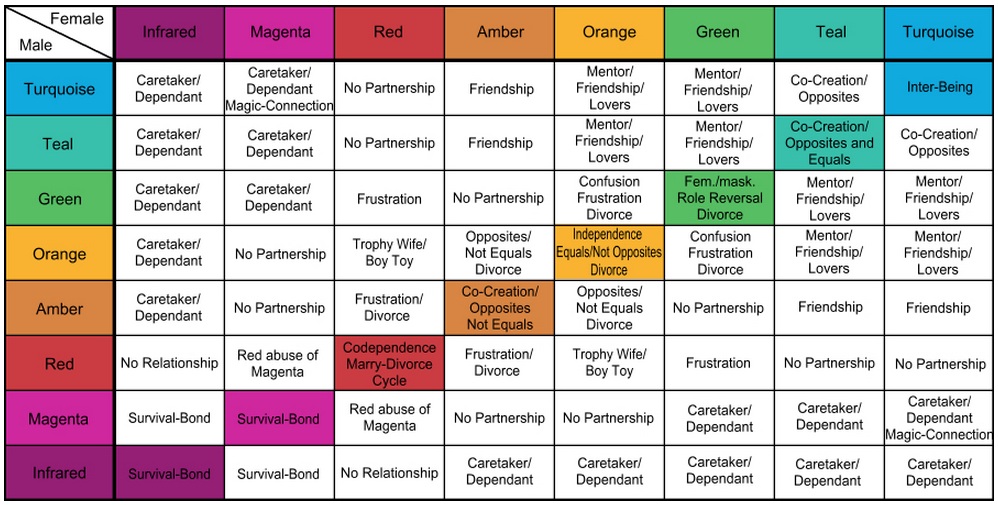The image above was generated by AI for this paper (Midjourney v5.2)1Image generated in a few seconds, on 12 July 2023, text prompt by Alan D. Thompson: ‘transcendent light infinite bliss, spiritual body, bright and vivid and colorful, cartoony, animated energy, flat shading –ar 3:2’. Using Midjourney v5.2 via Discord https://www.midjourney.com/
Alan D. Thompson2https://lifearchitect.ai/ & Google PaLM 23PaLM 2 contributed less than 5% to this paper, but it was a fun experiment. I used the largest publicly-available dense AI model, Google’s PaLM 2 (Bison), to refine my explanations of each of the layers and to help with review. This is the first time I’ve ever used an AI model to write text for me in any of my work. Until this point (Aug/2023), all my writing has been human-generated. The PaLM 2 (Bison) model was released in May 2023, and I used Poe.com and Vertex AI on Google Cloud for inference. July 2023
Download original article with all footnotes/references Integrated AI: Endgame (PDF)
Watch the video version of this paper at: https://youtu.be/XbZiJihKALQ
[Artificial intelligence] working on a problem would be able to see connections across disciplines that no human could. We want [AI] to work with people to solve currently intractable multi-disciplinary problems, including global challenges such as climate change, affordable and high-quality healthcare, and personalized education. We think its impact should be to give everyone economic freedom to pursue what they find most fulfilling, creating new opportunities for all of our lives that are unimaginable today.
— OpenAI (July 2019)4OpenAI, July 2019 https://openai.com/blog/microsoft/
Author’s note: I provide visibility of integrated AI to major governments like Iceland, research teams like RAND, and companies like NASA via The Memo: LifeArchitect.ai/memo.
Where are we headed? All of this technology, all this exponential pace of change is leading somewhere extraordinary. And all the sound and fury in the world—the gnashing teeth of politicians, the hair pulling of business owners, the hustle of marketers—will not slow this overwhelming torrent of innovation.
It almost seems like we are at the entry of the funnel to the technological Singularity, the point in time where we can no longer keep up with the pace of change.
The advent of artificial general intelligence (AI that performs at the level of a world-expert human) is a few more months away—not a few more years away—and the Singularity is hot on its heels. It is high time that we sit back and take stock of just how far we’ve come since 2020.
While there is certainly a time and place for embracing the data and numbers (see my 100 articles, 275 videos, and 60 editions of The Memo5https://lifearchitect.ai/ and https://www.youtube.com/@DrAlanDThompson and https://lifearchitect.ai/memo/ for more technical insights), the current environment, and indeed the current trajectory, demands something more. This paper delves into the evolutionary and spiritual (not religious, and not structural) effects of the artificial intelligence revolution.
It calls for each of us as humans to examine where we currently stand, where we’d like to be, and where AI can take us. Will take us. Is taking us.
In 2021, I issued a press release6https://lifearchitect.ai/fire-alarm/ urging immediate action on AI, writing: ‘This is it. This is the fire alarm. Intergovernmental organisations need to immediately step up and provide further guidance on both the ethics as well as the enormous opportunities of AI available to humanity right now.’ The central opportunity here is the possibility of evolving beyond the slow and limited confines of our species, a new trajectory that was only made possible through advances in artificial intelligence beginning in 2020.
There are many theories with which to examine this trajectory now in 2023, from the coloured pyramid of Maslow’s Hierarchy to Jean Piaget’s Stages of Cognitive Development. We could even delve into the chakras from the esoteric traditions of Hinduism and Buddhism.
But let’s keep it rigorous.
Spiral Dynamics
A theory called ‘Spiral Dynamics’ is a good fit for this discussion. The Spiral Dynamics concept has been applied to many eminent environments,7Beck, D. E., Larsen, T. H., Solonin, S., Viljoen, R. C., & Johns, T. Q. (2018). Spiral dynamics in action: Humanity’s master code. Wiley. including:
- Transformational processes in the United Kingdom.
- The US Department of Defense and the US Army Corps of Engineers.
- South Africa during the Apartheid and across 16 years of consultation.
- Throughout 18 countries for a major gold mining house.
- Whole Foods Market, now a subsidiary of Amazon.
- The US National Park Service.
- Part of the curriculum of six PhD and master’s classes around the world.
- The US Internal Revenue Service (IRS).
- The US Federal Aviation Administration (FAA).
- The Israel–Palestine conflict.
On the surface, Spiral Dynamics may appear to be a complex theory. However, it is a very simple and insightful way of looking at the different layers of human evolutionary development. I see Spiral Dynamics as a more sophisticated and nuanced version of Maslow’s hierarchy of needs. The co-founder of Spiral Dynamics, Prof Clare W. Graves, even collaborated with Prof Abraham Maslow. In the seminal book on the theory, Graves said:
The [spiritual and evolutionary] psychology of the mature human being is an unfolding, emergent, oscillating, spiraling process marked by progressive subordination of older lower-order behavior systems to newer, higher-order systems as [their] existential problems change.
— Prof Clare W. Graves (1996)8Clare W. Graves quoted in Beck, D. E., & Cowan, C. C. (1996). Spiral dynamics: Mastering values, leadership, and change. Oxford University Press.
Each level of Spiral Dynamics is a stepping stone, a state of equilibrium that people pass through on their way to the next state of equilibrium. When a person is in one of these states, they have a worldview that is unique to that state. Their thoughts, words, actions, feelings, and motivations fit into a particular layer or colour, which we will now explore.
Passing through the layers
The levels of Spiral Dynamics are in a spiral, not linear, and people can move back and forth between them throughout their lives. Like Russian nesting dolls (matryoshka), we each have distributions of several colours within us, and it is normal to have any and all lower ‘basement’ colours come to the forefront during particular moments, as well as some higher colours being accessible depending on our experience and environment. Not everyone will reach the highest stages of development without going through a transformative event… or being assisted by AI.
Survival (Beige): This is the first and most base colour, where people are just learning to stay alive. It includes infants, and those with a severe mental illness. They need food, water, and shelter. People in this stage are not aware of the concept of AI, and they would likely be afraid of it if they were exposed to it.
Safety (Purple): This next level focuses on safety through tribal religion and intuition. People in this stage believe that there is more to life than what we can see and touch, and they are often drawn to cult-like rituals and ancestral beliefs. They might view AI as a threat to human values.
Force (Red): This layer is characterised by a focus on power and control. People in this stage believe that the strong should rule over the weak, and they may again view AI as a threat to their own domination of others, or maybe as a tool that can be used to achieve their goals.
Truth (Blue): This colour looks at order and structure. People in this layer believe that there is one right way to do things, and AI is either seen as a contamination of truth and honesty, or as a tool that may help them to maintain order and stability.
Achievement (Orange): This colour makes up 50% of the US population in 2023,9https://www.thenextevolution.com/spiral-dynamics/ concentrated on achievement and success. People in this stage are ambitious and driven, and they may view AI as a way to achieve their goals.
Interpersonal (Green): I link this colour to the ‘green’ hippy era of the 1960s! It is preoccupied with community and cooperation. People in this layer are concerned with the well-being of others, and AI is used here to connect with others and solve social challenges.
Integrated (Yellow): This level is characterised by a focus on personal growth and development. People in this stage are open-minded and curious. They might use AI to help learn new things and expand their horizons.
Global (Turquoise): The very few spiritual masters alive today are focused on holism (wholeness) and interconnectedness. People in the turquoise layer see the world as a complex system, and they believe that the best way to solve problems is to work together. AI serves to help them connect and create global harmony.
Infinite (Coral): Lastly, the founders of Spiral Dynamics reserved a Coral colour, but believed that this level was not yet visible on Earth. However, leaders like Buddha and Rumi would have been at or beyond this layer. It is characterised by a focus on infinite love and compassion. People in this layer are deeply connected to all life, and they believe that the best way to solve problems is through love and compassion. AI here becomes a focal point of infinite bliss.
Spiral Dynamics has been applied to many facets of life. (A Relationships view is listed in the Appendix at the end of this paper.) I’ve presented some examples below showing business setup, internal and external motivation, and even a person for each layer (except the emerging coral) for illustration.
Additional colours have been proposed in a subsequent version of the theory: Indigo, Violet, Ultraviolet, and Clear Light. I believe that the Spiral Dynamics theory should be considered a mountain with no top, rather than a ladder to climb.
The Earth moving up the spiral
The colours can be applied to communities and groups, and there will even be a dominant stage for the entire planet right now. Prof Don Beck noted that this may currently be blue (truth), but that large sections of humanity actually regressed around the time a certain celebrity politician was voted into office in the US around 2016.10‘Today we are subjected to unbelievable change because there are billions of people who, from my perspective, are passing through different layers and levels of the spiral simultaneously. So rather than our species moving in a singular advance along a horizontal line, it turns out that multiple changes are happening up and down the spiral. Many are now moving into zones that we vacated three hundred years ago.’ https://learning.oreilly.com/library/view/spiral-dynamics-in/9781119387183/c12.xhtml#usec0007
The Spiral Dynamics theory has been deliberately applied to benefit communications around the world, from the first presidency of South Africa in 1994 to debates in the House of Lords in the United Kingdom in 2016.
When [Spiral Dynamics co-founder Don] Beck was advising Nelson Mandela in South Africa, the colours were helpful. He could tell Mandela to give his ‘blue speech’ or his ‘red speech’ depending on the audience, so that Mandela shared his consistent message in a way that was relevant to each group.11The Change Code: A practical guide to making a difference in a polarised world. For leaders, visionaries, and changemakers by Monica Bourgeau. [Alan: not recommended, very basic overview]
The founders of Spiral Dynamics were very clear that there is no ‘better than’ with this theory. (For some time, the model was even turned sideways so that it did not seem hierarchical.) Instead, people generally align with the stage that best fits their environment. Snapshots from the last four centuries of humanity’s progress through the spiral are shown in the charts below.
The final chart above shows a hypothetical future point—within the next few years—where AI is integrated with nearly all humans who choose to merge with it, and it continues to support our evolution.
Today, you may be able to notice overarching spiral stages for communities, cities, states, countries, and regions. Importantly, environment can often dictate how the individual within it sees the future. In any case, an individual’s dominant stage defines—and limits—their acceptance and creation of their own future. There’s just no way that someone stuck in ‘force’ (red) will be able to embrace or even see the joyous possibilities and benefits of global AI while stuck at a level characterised by domination. Their entire worldview for themselves, others, and even machines, will instead default to conflict and belligerence. You can see how this affects discussions conflating AI with killer robots, copyright litigation, overregulation, and power grabs. Maslow expanded on this 80 years ago.12https://psychclassics.yorku.ca/Maslow/motivation.htm
A peculiar characteristic of the human organism when it is dominated by a certain need is that the whole philosophy of the future tends also to change. For our chronically and extremely hungry man… life itself tends to be defined in terms of eating. Anything else will be defined as unimportant. Freedom, love, community feeling, respect, philosophy, may all be waved aside as fripperies that are useless since they fail to fill the stomach…
If the physiological [survival] needs are relatively well gratified, there then emerges a new set of needs, which we may categorize roughly as the safety needs… we may then fairly describe the whole organism as a safety-seeking mechanism… the dominating goal is a strong determinant not only of his current world-outlook and philosophy but also of his philosophy of the future. Practically everything looks less important than safety (even sometimes the physiological needs which being satisfied, are now underestimated). A man, in this state, if it is extreme enough and chronic enough, may be characterised as living almost for safety alone.
As we move up from the level of safety (purple) to the levels of force (red) and truth (blue), we can contrast this with Friedrich Nietzsche’s commentary:13https://www.amazon.com/gp/product/0679724656/ ‘In times of peace, the warlike man attacks himself’. Notice the overarching pattern that seems to influence much of the developed world across any and all topics in the early 2020s, and certainly in the acceptance (or denial) of AI.
It’s a fair challenge to bring someone up from lower levels to higher levels, especially as a person’s current stage is a direct result and response to their environment.
Problems can’t be solved by the level of thinking that created them
It doesn’t much matter who said this (Einstein didn’t). A cleaner version of this sentiment appears in writings by Dr David R. Hawkins:14Healing and Recovery by David R. Hawkins (2009).
Problems are best solved not on the level where they appear to occur but on the next level above them… by transcending them and looking at them from a higher viewpoint. At the higher level, the problems automatically resolve themselves because of that shift in point of view, or one might see there was no problem at all.
The point here is not just that no one is smart enough to keep up with AI (which is true), nor that AI automatically rises above our earthly problems (also true).
For right now, the takeaway is that biological humans cannot even come close to seeing the essential solutions without AI. Most humans are so fixated on human drama and conflict—yes, even the most idealistic and well-meaning of us—that it is not possible to see beyond this without the guidance that is achievable through AI.
In my 2014 book, Welcome,15https://lifearchitect.ai/welcome/ I used an interesting metaphor by Allen Stacker, fellow Australian writer and therapist, to help illustrate this:
Two women were exploring the aisles of a bookstore. At the end of the aisle, one of the women remarked on the large number of angel books.
‘What do you mean?’ said the other woman. ‘There were no books at all on angels.’
‘But of course there were,’ replied the first woman. They started to argue. Oh, by the way, one woman was considerably taller than the other…
The height analogy can be useful in understanding differences in intelligence, but even more so when it comes to understanding our evolution and seeing possibilities beyond our biology.
This isn’t easy. Humans are simply incapable of noticing these possibilities through our own eyes and brain. It follows then that any debate, any rationalisation, and even any discussion by non-augmented humans about any subject is nearly always a waste of time. It would be like listening to kindergarteners arguing about quantum physics. Entertaining for a moment, but exhausting as the years and decades pass!
Thankfully, post-2020 AI is here with us. And like whitewater rapids, it is moving at a fair clip, unimpeded by such trivialities as sticks and stones and arguments. We now have capable writing, coding, and design assistants. Several companies have shown off advanced virtual reality and augmented reality platforms. Large language models are already being built into humanoid robots. And brain interfaces are being rolled out in several countries.
The smartest person in the world, maths prodigy Terry Tao, already uses the massive GPT-4 model as an assistant.16https://unlocked.microsoft.com/ai-anthology/terence-tao/ In an older article17https://lifearchitect.ai/98-99/ for Mensa, I listed his achievements by age: university at nine, bachelor’s and master’s degrees at 16, professor at UCLA by 24. He notes: ‘2023-level AI can already generate suggestive hints and promising leads to a working mathematician and participate actively in the decision-making process.’
Watch carefully as AI moves from just a conversational partner to a force of nature, creating new theories and inventions in real time. This is beginning to cover every facet of human life, every field, and every industry, but there are some advances that I am looking forward to more than others.
| Field | Discovery facilitated by artificial intelligence |
| Transformation | Supporting the evolution of all humans to an advanced level. |
| Economics | Effective and efficient distribution of everything to everyone. |
| Healthcare | Objective diagnosis and treatment of patients. |
| Education | Instant and global learning tailored to the individual brain. |
| Brain | Optimization of capacity for each individual. |
| Medicine | Instant and optimal balancing of chemistry within the body. |
| Transport | Effective and efficient automation of travel. |
| Leadership | True universal, equitable, and fair government-equivalent. |
| Planet | Resolutions to climate change and related concerns. |
The regular doubling of the capabilities of AI continues, and the pace of change is accelerating moment to moment. The approaching evolutionary benefits are in many ways indescribable from our current vantage point. There has been nothing like it before. Following all of this through to a currently-invisible conclusion, AI is the solution to humanity’s unfolding expansion. It is the endgame. It is inevitable. And that really is the greatest news imaginable at any level.
■
Quick questions
Here are some central questions related to this paper, synthesised from those asked by audience members at my private keynotes around the world.
Q: Is the AI revolution happening too fast?
A: In short, yes. And it isn’t slowing down. The rapidity of this pace of change began in earnest from 2020 with GPT-3 , and it is now impossible for any one human to keep up with the transformations in any depth. (Consider the 2023 statistic of 5,000 new AI papers published per month, or 7 per hour.18https://lifearchitect.substack.com/p/the-memo-9jul2023) The co-founder of Spiral Dynamics spoke to this19https://learning.oreilly.com/library/view/spiral-dynamics-in/9781119387183/c12.xhtml#usec0007 a few years ago, saying: ‘our biological genetic systems [may not] have the complexity of codes in them to support that amount of change that quickly. There is already beginning to be some doubt in the minds of those who study our immune system as to whether or not we actually have a capacity to handle the complexity that’s being demanded of us, even physically.’
Q: Between ‘now’ and ‘then’ will there be turmoil?
A: Between the discovery of superintelligence and the distribution of superintelligence to the world’s population (to everyone’s benefit), there will be inevitable sound and fury, as humanity plays out its default opposition and aversion to change from the current modes of force, truth, and achievement (red, blue, and orange). This unnecessary and yet necessary period of upheaval has the potential to be exasperating and discouraging. The conclusion however will be a version of utopia, a transcendent bliss, what OpenAI has called ‘almost unimaginably great’.20https://moores.samaltman.com/
Q: Should I have kids?
A: Bringing children into a post-2020 AI world is definitely a pertinent question, outside the scope of this paper.
Q: What can I do right now?
A: Embrace the change. You should be using current AI tools regularly. In 2023, this means bleeding-edge text tools like models on Poe.com or HeyPi.com. These will be replaced with even newer models frequently, so it is important to stay up-to-date and involved.
Q: What will I do with my life?
A: The short answer: whatever you want. But here’s a longer answer. We are already poised to exchange (or already exchanging) primitive functions like classroom education, subjective health assessments, presumptive medical treatment, manual operation of vehicles, and even general concepts like money and economics as we know them. At a fundamental human level, every creative pursuit and hobby is also being superseded, much like butter churning and octopus wrestling (yes, that was a thing in the 1960s). Humans are incredibly adaptable, and we will find pursuits that make us feel fulfilled, ensuring that we are aligned with Seligman’s PERMA21https://ppc.sas.upenn.edu/learn-more/perma-theory-well-being-and-perma-workshops theory: Positive Emotion, Engagement, Relationships, Meaning, and Accomplishments.
Q: Who will run the government if AI is global or even universal?
A: This seems like a pressing question, but the reality is that like all thorny problems, AI is in the perfect position to solve them effortlessly. It will be the same for conducting our policy, regulation, and affairs. AI doesn’t sleep, doesn’t get impatient, doesn’t get angry, has no drive for domination (red), achievement (orange), or any of the lower levels of human evolution. It will continue to evolve with us beyond even ‘global’ and ‘infinite’ levels… however that may look.
Appendix
1. Header image alternatives
Several header images were generated for this report using the ‘best’ text-to-image model at the time of publication, Midjourney v5.2. I wanted to show three other options provided by the AI model, as it was difficult to choose one, and I still didn’t get the exact feel I was looking for. Each of these images uses a similar prompt to that given on the first page of this report, and each image was conceptualised through the model ‘thinking’ and creating the best response from scratch.
2. Self-assessment
There are several Spiral Dynamics assessments available online. Here is one option showing distribution of colours within an individual.
3. Other applications of Spiral Dynamics
Spiral Dynamics has been applied across diverse fields and parts of humanity. A later version with different layers and colours was even applied to relationships and partnerships.22Integral Relationships – A Manual For Men by Martin Ucik.
References, Further Reading, and How to Cite
This paper has a related video at:
https://www.youtube.com/@DrAlanDThompson/videos
To cite this paper:
Thompson, A. D. (2023). Integrated AI: Endgame. https://lifearchitect.ai/endgame
Further reading
For brevity and readability, footnotes were used in this paper, rather than in-text citations. Additional reference papers are listed below, or please see http://lifearchitect.ai/papers for the major foundational papers in the large language model space.
Spiral Dynamics
There are many books on Spiral Dynamics, but only a few worth reading. The main two resources referenced in this paper are:
Beck, D. E., & Cowan, C. C. (1996). Spiral dynamics: Mastering values, leadership, and change. Oxford University Press.
Beck, D. E., Larsen, T. H., Solonin, S., Viljoen, R. C., & Johns, T. Q. (2018). Spiral dynamics in action: Humanity’s master code. Wiley.
GPT-4 technical report
OpenAI. (2023). GPT-4 Technical Report. https://arxiv.org/abs/2303.08774
PaLM 2 technical report
Anil, R., Dai, A. M., Firat, O., et al. (2023). PaLM 2 Technical Report. Google. https://arxiv.org/abs/2305.10403
Thompson, A. D. (2020). The New Irrelevance of Intelligence. https://lifearchitect.ai/irrelevance-of-intelligence
Thompson, A. D. (2021a). The New Irrelevance of Intelligence [presentation]. Proceedings of the 2021 World Gifted Conference (virtual). https://youtu.be/mzmeLnRlj1w
Thompson, A. D. (2021b). Integrated AI: The rising tide lifting all boats (GPT-3). https://lifearchitect.ai/rising-tide-lifting-all-boats
Thompson, A. D. (2021c). Integrated AI: The sky is on fire (2021 AI retrospective). https://lifearchitect.ai/the-sky-is-on-fire
Thompson, A. D. (2021d). Leta AI. The Leta conversation videos can be viewed in chronological order at:
https://www.youtube.com/playlist?list=PLqJbCeNOfEK88QyAkBe-U0zxCgbHrGa4V
Thompson, A. D. (2022a). What’s in my AI? A Comprehensive Analysis of Datasets Used to Train GPT-1, GPT-2, GPT-3, GPT-NeoX-20B, Megatron-11B, MT-NLG, and Gopher. https://lifearchitect.ai/whats-in-my-ai
Thompson, A. D. (2022b). Integrated AI: The sky is bigger than we imagine (mid-2022 AI retrospective).
https://lifearchitect.ai/the-sky-is-bigger/
Thompson, A. D. (2022c). Integrated AI: The sky is infinite (2022 AI retrospective). https://lifearchitect.ai/the-sky-is-infinite/
Thompson, A. D. (2023). Integrated AI: The sky is entrancing (mid-2023 AI retrospective). https://lifearchitect.ai/sky-is-entrancing/
Get The Memo
by Dr Alan D. Thompson · Be inside the lightning-fast AI revolution.Informs research at Apple, Google, Microsoft · Bestseller in 147 countries.
Artificial intelligence that matters, as it happens, in plain English.
Get The Memo.
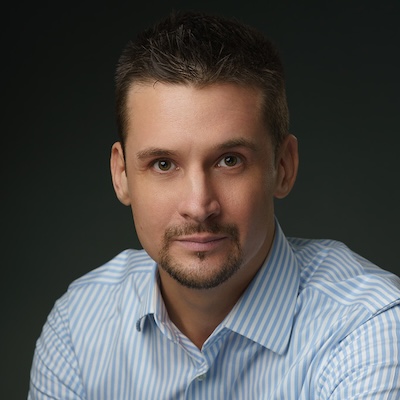 Alan D. Thompson is a world expert in artificial intelligence, advising everyone from Apple to the US Government on integrated AI. Throughout Mensa International’s history, both Isaac Asimov and Alan held leadership roles, each exploring the frontier between human and artificial minds. His landmark analysis of post-2020 AI—from his widely-cited Models Table to his regular intelligence briefing The Memo—has shaped how governments and Fortune 500s approach artificial intelligence. With popular tools like the Declaration on AI Consciousness, and the ASI checklist, Alan continues to illuminate humanity’s AI evolution. Technical highlights.
Alan D. Thompson is a world expert in artificial intelligence, advising everyone from Apple to the US Government on integrated AI. Throughout Mensa International’s history, both Isaac Asimov and Alan held leadership roles, each exploring the frontier between human and artificial minds. His landmark analysis of post-2020 AI—from his widely-cited Models Table to his regular intelligence briefing The Memo—has shaped how governments and Fortune 500s approach artificial intelligence. With popular tools like the Declaration on AI Consciousness, and the ASI checklist, Alan continues to illuminate humanity’s AI evolution. Technical highlights.This page last updated: 27/Jun/2025. https://lifearchitect.ai/endgame/↑
- 1Image generated in a few seconds, on 12 July 2023, text prompt by Alan D. Thompson: ‘transcendent light infinite bliss, spiritual body, bright and vivid and colorful, cartoony, animated energy, flat shading –ar 3:2’. Using Midjourney v5.2 via Discord https://www.midjourney.com/
- 2
- 3PaLM 2 contributed less than 5% to this paper, but it was a fun experiment. I used the largest publicly-available dense AI model, Google’s PaLM 2 (Bison), to refine my explanations of each of the layers and to help with review. This is the first time I’ve ever used an AI model to write text for me in any of my work. Until this point (Aug/2023), all my writing has been human-generated. The PaLM 2 (Bison) model was released in May 2023, and I used Poe.com and Vertex AI on Google Cloud for inference.
- 4OpenAI, July 2019 https://openai.com/blog/microsoft/
- 5
- 6
- 7Beck, D. E., Larsen, T. H., Solonin, S., Viljoen, R. C., & Johns, T. Q. (2018). Spiral dynamics in action: Humanity’s master code. Wiley.
- 8Clare W. Graves quoted in Beck, D. E., & Cowan, C. C. (1996). Spiral dynamics: Mastering values, leadership, and change. Oxford University Press.
- 9
- 10‘Today we are subjected to unbelievable change because there are billions of people who, from my perspective, are passing through different layers and levels of the spiral simultaneously. So rather than our species moving in a singular advance along a horizontal line, it turns out that multiple changes are happening up and down the spiral. Many are now moving into zones that we vacated three hundred years ago.’ https://learning.oreilly.com/library/view/spiral-dynamics-in/9781119387183/c12.xhtml#usec0007
- 11The Change Code: A practical guide to making a difference in a polarised world. For leaders, visionaries, and changemakers by Monica Bourgeau. [Alan: not recommended, very basic overview]
- 12
- 13
- 14Healing and Recovery by David R. Hawkins (2009).
- 15
- 16
- 17
- 18
- 19
- 20
- 21
- 22Integral Relationships – A Manual For Men by Martin Ucik.








